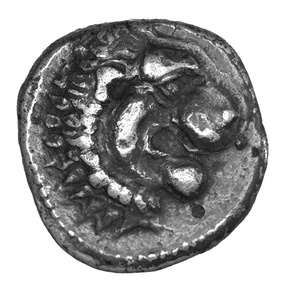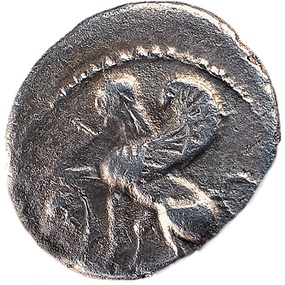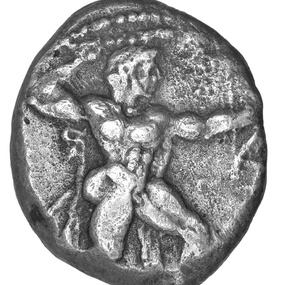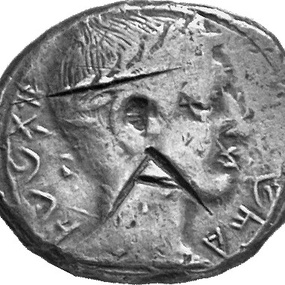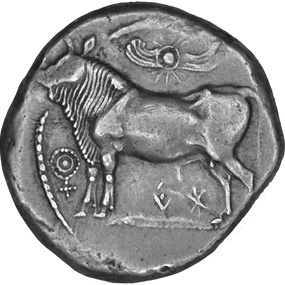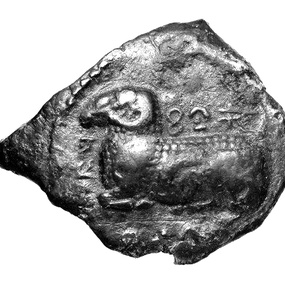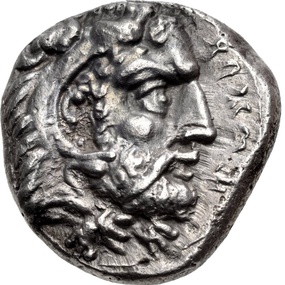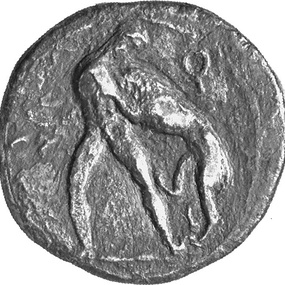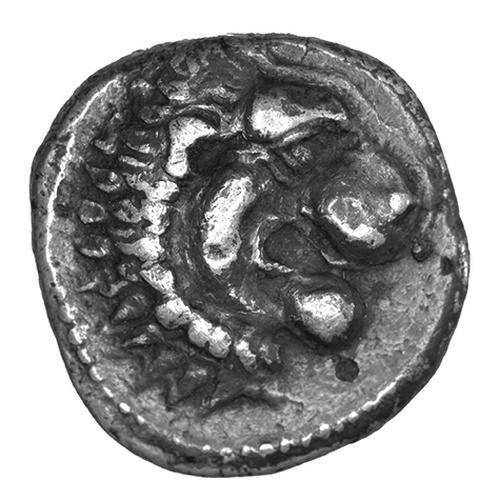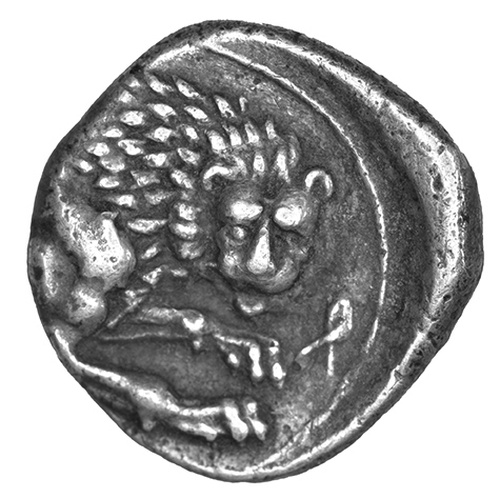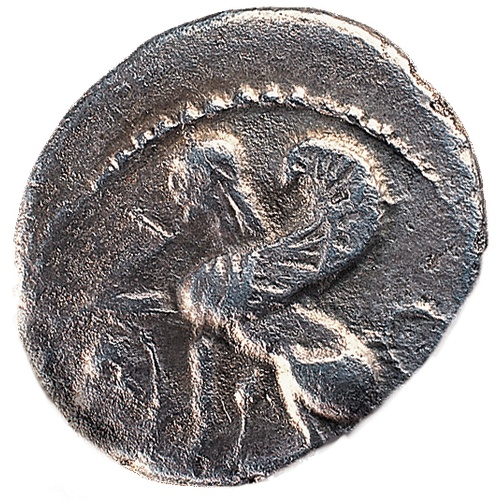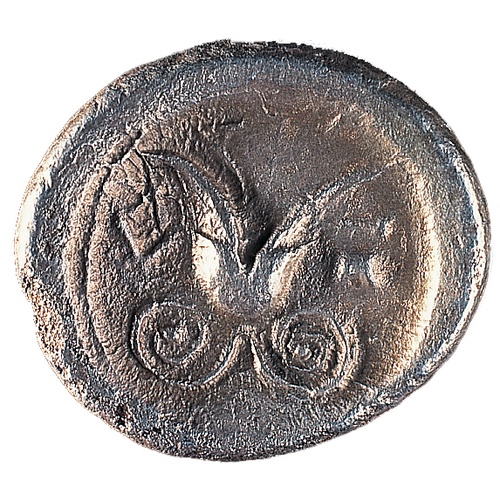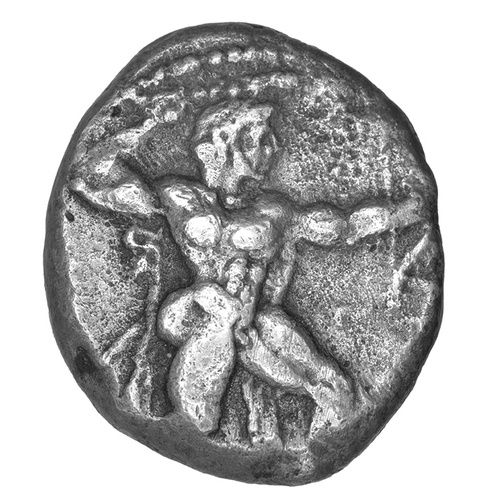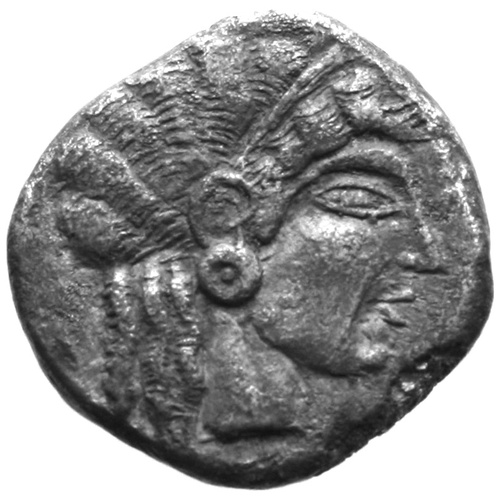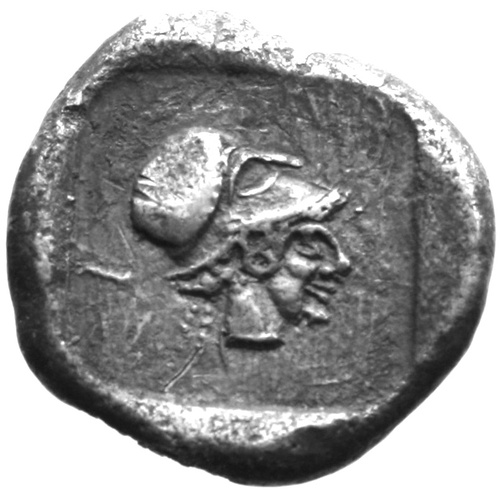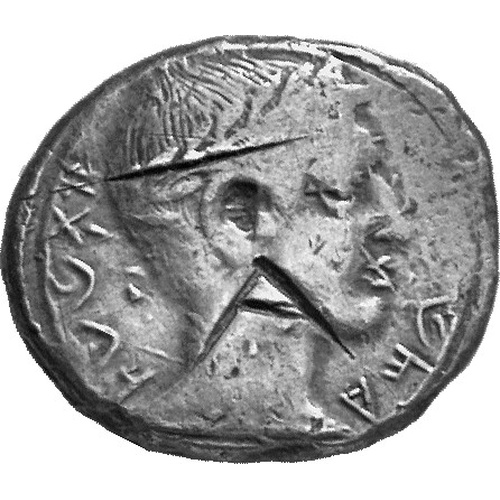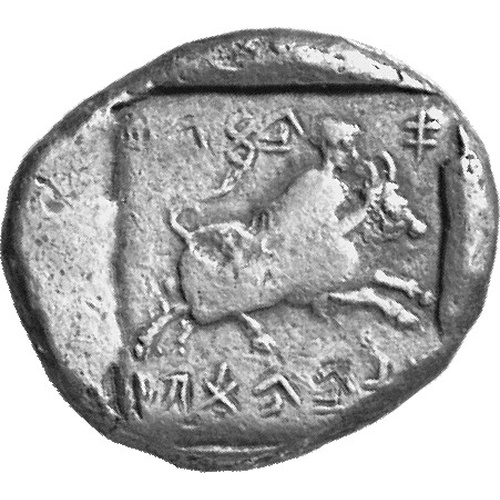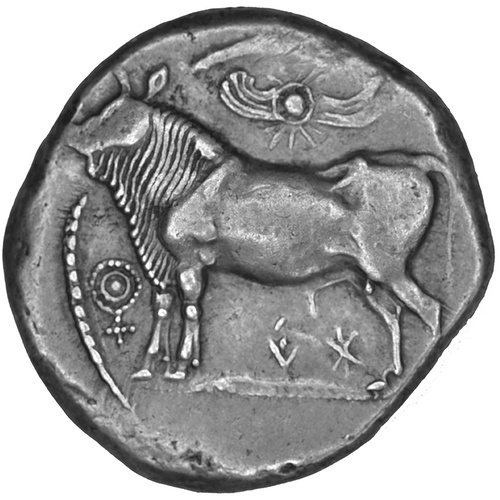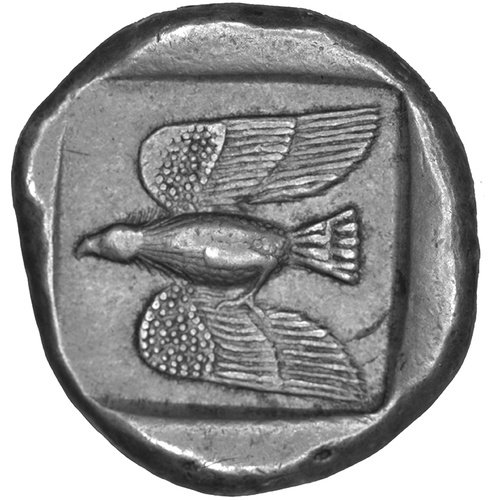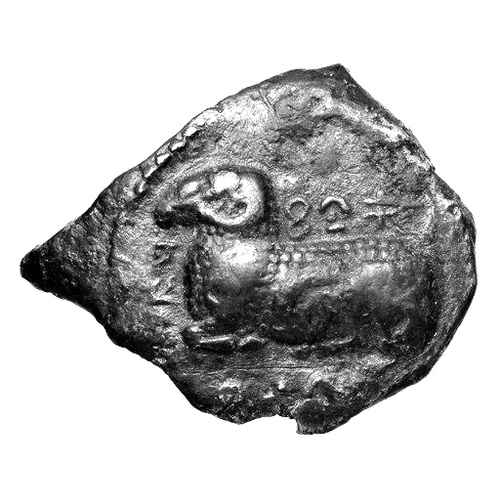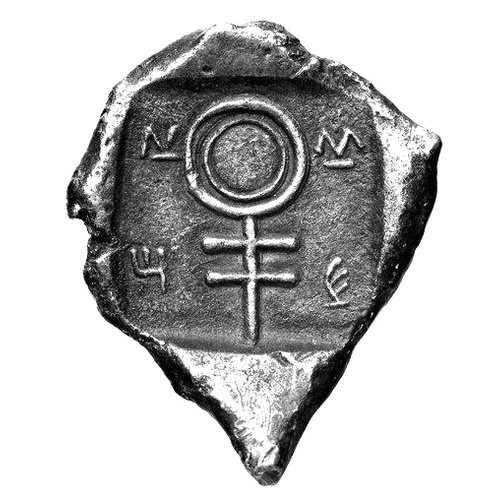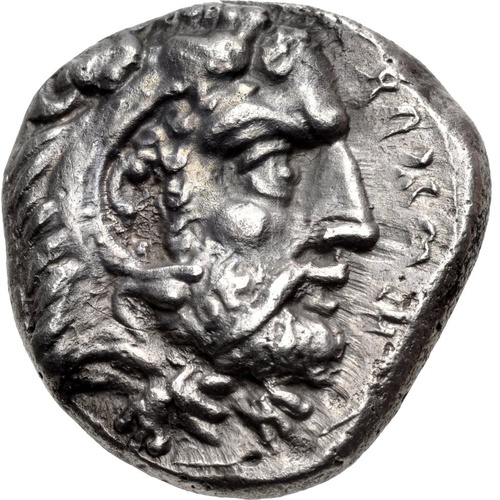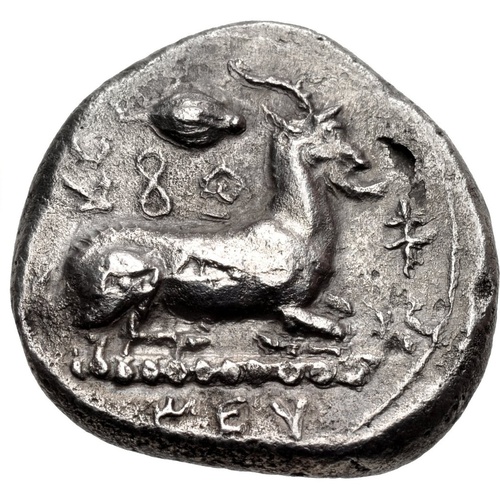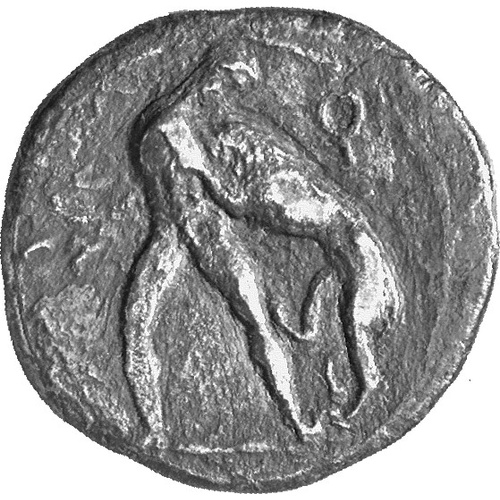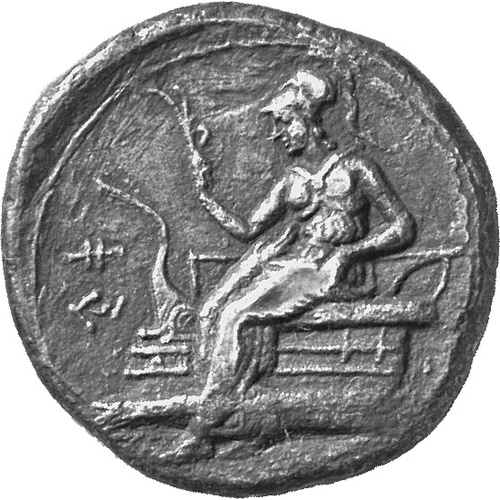The island of Cyprus, situated at the eastern end of the Mediterranean, has always been a significant crossroad of cultural interchange between the East and the West. Important information related to the history of the island of the 6th and 5th centuries BC has been preserved by ancient authors and other primary sources including archaeological finds, inscriptions and coins. It is this last category of evidence, the coins, that is presented on the Kyprios Character. History, Archaeology and Numismatics of Ancient Cyprus website as an outcome of the SilCoinCy research project. The present contribution aims to deliver a brief overview of the Cypriote coinages that will provide basic information to the interested reader; it also aims to highlight the Numismatic Database of the website, that will be soon accessible, where coins of various denominations and weight standards issued by the Cypriote kings have been collected from public and private collections from around the world.1
At the beginning of the 5th century BC, Cyprus formed part of the fifth satrapy of the Persian empire, along with Phoenicia, Syria and Palestine. The satrapy paid an annual tribute of 350 talents to the king of Persia and provided him with naval contingents when required (Hdt 3.91).2 In the 4th century, after the battle of Issos in 333 BC, Cyprus became part of Alexander the Great’s possessions; his death made of the island a battleground among his successors (primarily Antigonos and Ptolemy), each with the support of different Cypriote kings. Ptolemy I finally conquered the island in 294 BC, after having abolished the Cypriote kingdoms in the period between 312 BC and 306 BC.
In the middle of the 4th century BC, there were nine Cypriote cities, according to the historian3 Diodorus, although those cities are not named in the passage:
ἐν γὰρ τῇ νήσῳ ταύτῃ πόλεις ἦσαν ἀξιόλογοι μὲν ἐννέα, ὑπὸ δὲ ταύτας ὑπῆρχε τεταγμένα μικρὰ πολίσματα τὰ προσκυροῦντα ταῖς ἐννέα πόλεσιν. ἑκάστη δὲ τούτων εἶχε βασιλέα τῆς μὲν πόλεως ἄρχοντα, τῷ δὲ βασιλεῖ τῶν Περσῶν ὑποτεταγμένον.
***
For in this island were nine populous cities, and under them were ranged the small towns which were suburbs of the nine cities. Each of these cities had a king who governed the city and was subject to the King of the Persians.
Diod. Sic. 16.42.4
By the time of Diodorus' citation some of the cities had been absorbed by others (as Idalion had been by Kition) or even sold to others (as Tamassos to Kition). The names of some of those cities such as Salamis, Karpaseia, Kyrenia, Lapethos, Soloi, Marion and Amathous are mentioned by Pseudo-Scylax (Periplus 103), where mention is also made on the different ethnic groups that compose them.
Coins have been attributed with certainty to the kings of Salamis, Kition, Amathous, Paphos, Marion, Soloi and Lapethos, while several uncertain issues might have been minted by Kourion and/or by kings that ruled in still unidentified kingdoms.4 The coin legends on the Cypriote coins are either in Cypriote-Syllabic script (the local script) or in Phoenician, and from the 4th century onwards also in Greek. In some cases the Cypriote-Syllabic legends coexist with the Greek ones on the same coins (for example on the silver coinages of king Evagoras I of Salamis).
General characteristics of the Cypriote coinages of the Archaic and Classical periods
The earliest coins issued by Cypriote kings were of silver and were issued in the late 6th century BC, according to hoard evidence discovered in Cyprus and abroad.5
They seem to follow a common "local" weight standard based on a siglos of circa 11 grammes and divided into thirds, sixths, twelfths, and so on. The fact that the weight standard used in Cyprus was independent of that used in other parts of the Persian empire is an indication of the internal independence of the kingdoms and of the absence of direct Achaemenid influence and control.6
In the 4th century BC, several developments in the structure of the coinages are attested: large silver denominations seem to give way to smaller silver fractions (most commonly thirds or sixths) according to hoard evidence; at the same time coinages in gold and in bronze are minted as well.7 Furthermore, while some kingdoms retained the local weight standard of circa 11 grammes, others replaced it with a reduced standard, the so-called “Rhodian” or “Chian” following other areas of the East, such as Caria, probably to facilitate trade or to find a solution to the decline in silver stocks.8
Dating the Cypriote coinages
Although many details of the dating, attribution and interpretation of the Cypriote coinages still remain uncertain, much progress has been made in recent years. For example, the detection and the study of overstrikes, whether on imported coins or on local ones, has helped to narrow down both the relative and the absolute dating of many coin issues.9
At the same time, the evidence of hoards either complements such conclusions or permits the attribution of a coin or a group of coins to a particular mint. Hoard evidence can be revealing in other ways too, especially with regard to circulation within and beyond the island: coins of the Cypriote kingdoms have been found beyond their borders, including many parts of the former Achaemenid empire: in Phoenicia, Cilicia, Pamphylia, Jordan, and as far east as Afghanistan.10
Iconography
The iconography of Cypriote royal coinages varies from kingdom to kingdom, and often from king to king. While in the 5th century BC the coin types are mostly animals, though with exceptions (for example, the coins of Marion showing Phrixos and Europa riding a bull), in the 4th century BC a range of Greek divinities appears, such as Athena, Apollo, Zeus and Aphrodite, assimilated with the local gods.
The Greek hero Herakles is a very common image on Cypriote coins and we find him (for almost two centuries) on the obverse of the coins of the kings of Kition, where he is assimilated with the Phoenician god Milqart. In Cyprus Herakles seems to have been considered more of a god than a hero.11
Other elements borrowed from areas like Egypt or Phoenicia are also perceptible on Cypriote coins. A very common symbol is the ankh (the Egyptian symbol of life) that appears as the main reverse type on the early coins of Salamis (amongst others), but also as an additional symbol on many Cypriote mints (Paphos, Marion, Kition), while the Phoenician sign of Tanit (a complex sign indicating the principal feminine goddess of the pantheon) can be seen on the gold and bronze coinage of king Pumayyaton of Kition.12
The Coins of the Cypriote Kingdoms: General Overview
Amathous
Early coinage
The kingdom of Amathous is known from literary sources and the coinages produced by its kings were studied via a coin die study by M. Amandry.13 The earliest groups of silver coins of the kings of Amathous with a lion as the main iconographic type, also found on later coins, are dated between 460 and 430 BC and can be assigned to three kings.
The first group of coins bears no legends, the second attests the name of a king Rhoïkos in Cypriote-syllabic script, who issued sigloi with a recumbent lion on the obverse, and the forepart of a lion on the reverse, as well as smaller denominations.
The third group attests the name of a king known to us only by the single Cypriote-Syllabic sign ? (mo), which appears on sigloi with a recumbent lion, with an eagle flying above, on the obverse, and a forepart of a lion on the reverse.
The following group of coins is attributed to Amathous because of the types described above (recumbent lion and forepart of a lion), but is struck on a different weight standard. On these didrachms of the so-called “Rhodian” or “Chian” weight standard, a Greek letter E appears in the exergue of the obverse – that is the horizontal line that defines the lower part of the image. This combination of features has been connected with the years 391-386 BC, when King Evagoras I of Salamis extended his power to parts of the island outside his own kingdom, even by conquering Amathous. But although interesting, this hypothesis is still under discussion and, because of the economic politics of the king of Salamis, it is even more difficult to support.14
Later coinage
Literary sources refer to a second king Rhoïkos to whom coins issued on the so-called “Rhodian” or “Chian” weight standard have been attributed, with a lion's head on the obverse and the forepart of a lion to right, head facing on the reverse [Fig. 1], with the Cypriote-Syllabic sign ? (ro). Tetrobols, obols and smaller fractions of the same weight standard but without legends have also been assigned to this same king, whose reign is placed either in the beginning or in the middle of the 4th century.15
A group of three kings, who reigned possibly in the late 380s, is revealed by their respective coinages. The names of Pyrrwos and Zotimos are inscribed on their coin issues in Cypriote- Syllabic script. Both appear to have retained the so-called “Rhodian” or “Chian” weight standard and the established iconography of the kingdom: the recumbent lion with the eagle on the obverse, and the forepart of a lion on the reverse. The name of the third king, who overstruck coins of his predecessor to create his own, is known in the incomplete form (-) timos in Cypriote-Syllabic script.
The last two kings of Amathous whose names are known to us exclusively from the Cypriote-Syllabic legends on their coins are Lysandros and Epipalos, who rule in 380-370 and 370-360 BC respectively. Androkles, the king of Amathous of the second half of the 4th century BC, only appears in literary and epigraphic sources that inform us, amongst others, about his action during the episodes related to Alexander’s presence in Cyprus (Arr., Anab. 2.22.2), and about the fact that he dedicated gold wreath to Appollo of Delos in 313 BC.16
Idalion
Early coinage
The earliest coins attributed to the kings of Idalion are dated after 500 BC, and depict a Sphinx seated on the obverse, and an incuse square on the reverse. This uninscribed series was followed by an issue with the same types; however, on the obverse there was an addition of two Cypriote-Syllabic signs, which no doubt attest the name of the king who minted them, but whose interpretation is problematic. Hoard and overstrike evidence combine to suggest a date early in the 5th century for this issue.17
A third issue with the same types shows a rose in the right field of the obverse, and on the reverse the legend ? ? ? (e-ta-li) in Cypriote-Syllabic script, referring to the name of the coin (Edalikon or Edalieus). 18 This is rare on Cypriote coinage although not unique to Idalion, since we also find it on the coins of Marion ? ? ? ? ? (ma-ri-e-u-se).
The series is followed by a group of coins with a more elaborate reverse design: a lotus flower on two spiral tendrils. The obverse retains the seated Sphinx with the addition of two flowers on each side and the incomplete name of a king, Ki (-), in Cypriote-Syllabic script. An important clue for the dating of this issue was the discovery of a specimen overstruck on a siglos of King Baalmilk I of Kition, whose reign began after 480 BC.19
Stasikypros
The tablet of Idalion, containing the longest text written in the Cypriote-Syllabic script so far found, records an agreement made by the king and the city of Idalion with a doctor of medicine and his brothers, who were responsible for healing the injured after an unsuccessful attempt by the “Medians and Kitians” to capture Idalion, before they finally succeeded after 450 BC.20
Thirds and twelfths of a siglos of the local weight standard bearing the same types (sphinx/lotus flower) and the Cypriote-Syllabic sign ? (sa) [Fig. 2], have been attributed to Stasikypros, although no coin with a complete legend has been found. These coins, dated to the middle of the 5th century BC, are the last coins of Idalion to have been issued before it was conquered by Kition; subsequently the name of the city appeared only as part of the title of the kings of Kition (“king of Kition and Idalion”).
Kition
Early coinage
The earliest coins, without inscription, attributed to the kings of Kition, are sigloi on the local weight standard of circa 11 grammes, with a recumbent lion turning its head on the obverse, and a smooth reverse. These are followed by a group composed of smaller denominations with a recumbent lion on the obverse, and a lion seated on the reverse. We know the names of three successive kings in the dynasty of Kition from epigraphic evidence, mainly from the following inscription discovered in Idalion:21
Baalmilk II king of Kition and Idalion, son of Ozibaal king of Kition and Idalion, son of Baalmilk I king of Kition
The inscription shows that the capture of Idalion by Kition occurred in the reign of Ozibaal, yet the date of this important event is controversial lingering between 470 and 450 BC.
Silver coins of various denominations have been attributed to all the above kings, Baalmilk I, Ozibaal [Fig. 3], and Baalmilk II, differentiated by the legends in Phoenician that attest their names and by the iconography. The obverse type is always Herakles (assimilated with the Phoenician Milqart) walking right, wearing a lion's skin on his head and holding a club and a bow; on the coinage of Baalmilk I the reverse type is a seated lion with open jaws while smaller denominations display only a bearded head of Herakles on the obverse and the same reverse. From Ozibaal onwards the lion on the reverse will be replaced by the representation of a lion devouring a stag, that will be also adopted by all of his successors.
Fourth-century coinage
In the 4th century, a combination of epigraphic and numismatic evidence allows us to date the reigns of the three known kings of Kition with accuracy. The first of them, Baalrom, succeeded Baalmilk II around 400 BC; he adopted the same types as his predecessor placing his own name on the reverse. Milkyaton succeeded as king in 392/391 BC (a date that occurred by the discovery of a trophy which bore an inscription with mention of the king’s first regnal year),22 and he reigned for at least thirty years up to 362/1. He issued silver sigloi and thirds on the local weight standard of circa 11 grammes and, for the first time in Kition, gold coins with the same types as those of his predecessors, from Ozibaal onwards, but with his own name. A series of bronze coins attributed to him because of the Phoenician letter ? (mem) on the obverse, initial of his name, shows for the first time at Kition a head of Aphrodite wearing a decorated stephane.
Milkyaton was succeeded by his son Pumayyaton, who reigned at Kition from 362/361 to 312 BC. The numbers of the regnal years indicated on the reverse of his, mainly gold, coinage suggest that he reined for at least 46 years, a very long regal period.23 This is the only case in Cyprus of such numbering on coins, though it is attested in Phoenicia already in the middle of the 5th century. A combination of epigraphic and literary evidence informs us that in the 21st year of his reign (342/341 BC), Pumayyaton was king of Kition, Idalion and Tamassos; because of debts, the king of Tamassos had sold his kingdom and the title that went with it to Pumayyaton for fifty talents. However, after his capture of Tyre in 332 BC, Alexander the Great offered Tamassos as a gift to the king of Salamis, Pnytagoras.
Δοῦρις δ᾽ ἐν ζ Μακεδονικῶν (FGrH 76 F 4) περὶ Πασικύπρου λέγων τοῦ ἐν Κύπρῳ βασιλέως ὅτι ἄσωτος ἦν γράφει καὶ τάδε: Ἀλέξανδρος μετὰ τὴν Τύρου πολιορκίαν Πνυταγόραν ἀποστέλλων ἄλλας τε δωρεὰς ἔδωκε καὶ χωρίον ὃ ᾐτήσατο. πρότερον δὲ τοῦτο Πασίκυπρος [ὁ] βασιλεύων ἀπέδοτο δι᾽ἀσωτίαν πεντήκοντα ταλάντων Πυγμαλίωνι τῷ Κιτιεῖ, ἅμα τὸ χωρίον καὶ τὴν αὑτοῦ βασιλείαν καὶ λαβὼν τὰ χρήματα κατεγήρασεν ἐν Ἀμαθοῦντι.
***
Athen. 4.167c-d
The end of the 4th century BC
Numismatic evidence offers further insights into political alignments at the time of Alexander's presence in the Eastern Mediterranean. The coinage of year 30 (333/332 BC) of Pumayyaton is particularly prolific and possibly attests his preparations for war against Alexander and his intention to help his Phoenician allies.
Between his regnal years 33 (330/329) and 39 (324/323), Pumayyaton appears not to have issued coins (the mint of Kition may have been used to strike Alexander's coins), but after Alexander's death in 323/322, Pumayyaton resumed striking coins until he was put to death by Ptolemy in 312 (Diod. Sic. 19.79.4). We can attribute a series of bronze coins to Pumayyaton formerly thought to have been issued by King Evagoras II of Salamis in the middle of the 4th century BC. The types figure on the obverse a lion walking left, with a ram's head in the field above, and on the reverse a horse, walking left, with a star of eight rays above, and the Phoenician sign of Tanit in the left field.24
Lapethos
Early coinage
The earliest coins of the kings of Lapethos, dated in the beginning of the 5th century BC, are uninscribed sigloi that follow the local weight standard of circa 11 grammes, with a head of Athena wearing a crested Corinthian helmet on the obverse; and on the reverse, either Herakles kneeling or the bearded head of the same hero. The attribution of these coins to Lapethos is based on the fact that the same types appear on later coins bearing the names of kings of Lapethos and the dating is based on hoard evidence of the end of the 6th century BC. Uninscribed coin issues that are also attributed to the kings of Lapethos represent a female head with a circular earring on the obverse and a head of Athena wearing a Corinthian helmet in an incuse square on the reverse [Fig. 4]. The first such king is Demonikos (I) or Demonas, whose name is written in Phoenician on the reverse of sigloi with a head of Athena on both obverse and reverse. He reigned around 500 BC, and a recently discovered issue, with the same types, reveals the name of another king, Ba'alzakor, who must have reigned in the first half of the 5th century.
Sidqmilk and his successors
The following king, Sidqmilk, ruled before the middle of the 5th century. He is known from an exceptional issue showing on the obverse a head of Athena wearing a Corinthian helmet and the legend in Phoenician letters, “of Sidqmilk, king of Lapethos” (this is one of the rare cases in Cyprus where the names of the king and of the kingdom appear together). The reverse depicts a facing head of Athena wearing a helmet decorated with two bull's horns and ears and two crests and the legend, again in Phoenician letters, “Sidqmilk”.
After the reign of Sidqmilk, hoard evidence attests the circulation of uninscribed coins of the local weight standard having the head of Athena in crested Corinthian helmet on the obverse and the head of a bearded Herakles wearing a lion's skin on the reverse. The coins appeared in the area of the kingdom of Lapethos in the last quarter of the 5th century.
The next known king, Andr (-), is represented by an exceptional issue discovered in the Vouni hoard: on the obverse, Athena stands wearing a tunic and peplos, holding a spear in her right hand and a round shield in her left; on the reverse, Herakles walks to the right, holding a club and bow, and the legend in Phoenician letters reads “of king Andr (-) (king of) Lapethos”.25
Coins with the same types, attesting the name of his successor Demonikos (II ?), were also found in the same hoard. Either or both of these kings issued fractions with the same types, but the precise attribution is uncertain since they bear no legend. The reigns of these two kings span the last years of the 5th century and the early years of the 4th. It was either Demonikos (II ?) or perhaps a third Demonikos (III ?) in the dynasty of Lapethos who issued coins with the same types, and for the first time in this kingdom the obverse legend was in Greek letters: BA and ΔH (the first two letters of the king's title and the first two letters of the king’s name).26
Around 350 BC is dated the reign of a king Βarik Shamash, whose surviving silver coins are small denominations bearing an abbreviated letter in phoenician alphabet linked to his name, as shown by epigraphic evidence.27
The last king of Lapethos, Praxippos, most probably issued bronze coins inscribed on both sides with Greek letters: on the obverse ΠΡ (the first two letters of the king's name) with a head of Apollo and on the reverse BA (the first two letters of the Greek word for “king”) with a two-handled krater.28
Marion
Early coinage
The earliest coinage of Marion consists of silver sigloi and thirds of the local weight standard of circa 11 grammes, showing on the obverse a crouching lion and on the reverse the naked figure of Phrixos holding the left horn of a ram which runs left. The reverse legend “Marieus” in Cypriote-Syllabic script guarantees the attribution of these coins to Marion, while the obverse inscription, in Cypriote-Syllabic script: ? ? ? ? ? ? ? ? ? ? (sa-sa-ma-o-se / to-ka-sa-to-ro) “(of king) Sasmaos (son of) Doxandros”, gives us the name of the king, Sasmas. The presence of the name and the patronym on the same coin is unique in Cypriote coin production, as unique is the mythological representation of the reverse.
The combination of overstrikes and hoard evidence indicates in the beginning of the 4th century BC the order of the reigns of the next two kings, Stasioikos I and Timocharis [Fig. 5]. The types on the silver sigloi and thirds of local weight standard of Stasioikos I are a laureate head of Apollo on the obverse, and on the reverse Europa suspended from the bull (Zeus in disguise);29 on both sides the legend in Cypriote-Syllabic script reads “of king Stasioikos”. The types on the sigloi of Timocharis are the same as those of his predecessor, but the legend is different and it reads “of king Timocharis, Marieus”. His fractions (thirds, sixths and twelfths of a siglos) adopt the same iconography.
The last king of Marion
Literary evidence has shown that the last king of Marion, Stasioikos II, was arrested in 312 BC by Ptolemy I of Egypt; his city was destroyed and its inhabitants were transported to (Nea) Paphos.
Πτολεμαῖος δέ, τῶν περὶ Κυρήνην αὐτῷ κατὰ νοῦν ἀπηντηκότων, διῆρεν ἐκ τῆς Αἰγύπτου μετὰ δυνάμεως εἰς τὴν Κύπρον ἐπὶ τοὺς ἀπειθοῦντας τῶν βασιλέων. Πυγμαλίωνα δὲ εὑρὼν διαπρεσβευόμενον πρὸς Ἀντίγονον ἀνεῖλε, Πράξιππον δὲ τὸν τῆς Λαπιθίας βασιλέα καὶ τὸν τῆς Κερυνίας δυνάστην ὑποπτεύσας ἀλλοτρίως ἔχειν συνέλαβε Στασιοίκου τοῦ Μαλιέως: καὶ τὴν μὲν πόλιν κατέσκαψε, τοὺς δ᾽ ἐνοικοῦντας μετήγαγεν εἰς Πάφον.
***
After affairs in Cyrene had been settled to his satisfaction, Ptolemy crossed from Egypt to Cyprus with a force to oppose those of the kings who were refusing to obey him. Finding Pygmalion (Pumayyaton) discussing terms with Antigonos he executed him, and suspecting that Praxippos, the king of Lapethos, and the ruler of Kerynia were hostile to him he arrested him; also the king of Marion, Stasioikos, he then destroyed his city and transferred its inhabitants to Paphos.
Diod. Sic. 19.79.4
Before these events took place, the coinage of Stasioikos II incorporated many significant changes from the previous patterns of coinage at Marion. He was the first of its kings to issue gold coins in this kingdom, with a head of Zeus wearing a laurel wreath on the obverse, and a head of Aphrodite wearing a myrtle wreath on the reverse, with inscriptions written in both Cypriote-Syllabic script and Greek letters. His silver coins bear the same types, but were issued on the so-called “Rhodian” or “Chian” weight standard. His smaller fractions show either the same obverse and reverse types, or bear a laureate head of Apollo on the obverse and an ankh with a double crossbar and the Cypriote-Syllabic sign ? (sa) within the ring on the reverse. Finally, Stasioikos II issued a rich variety of bronze coins, for example issues with the head of Aphrodite on the obverse and an ankh within a laurel wreath on the reverse.30
Paphos
The successive kings of Paphos are known to us from literary sources, epigraphic finds, and primarily by their coin production, dated from the end of the 6th century to 310/309 BC.31 The earliest coins are sigloi on the Cypriote local weight standard of circa 11 grammes, featuring a kneeling bull with a human face on the obverse, and on the reverse an astragalos (a symbol that refers to the consultation of oracles through the casting of dice), with the name of Siromos in Cypriote-Syllabic script.
The silver sigloi of the next king, A (-), whose name is partially preserved as it problably starts with the Cypriote-Syllabic sign ? (a), depict a walking bull on the obverse and the head of an eagle on the reverse. The following king’s name is partly known as (-) timo while the third of the early kings, Pny (-), employs the same iconography and the same weight standard as his predecessors.
Stasandros and his successors
The following king, Stasandros, who, according to hoard evidence, reigned in the second half of the 5th century, retained the iconography of the bull on the obverse of his silver sigloi, but inaugurated a new reverse type, an eagle standing with wings closed, with an ankh (or occasionally a small vase and an ivy leaf) in front of its claws and his name in Cypriote-Syllabic script: ? ? ? ? ? ? ? (sa-ta-sa-to-ro / pa-si), (of) king Stasandros”. Stasandros, also issued smaller silver fractions such as sixths, twelfths and twenty-fourths of a siglos.
His three successors, Mineus, Zowalios and Pnytos, all issued sigloi with the same types. The presence of coins of the first two kings in the Vouni hoard, allowed us not only to confirm their succession but also the dating of the coinages.32
Towards the end of the 5th century, the next king, Onasi (-), issued sigloi and smaller denominations on the local weight standard showing a bull walking left, accompanied above by a winged solar disk (a mihr) on the obverse, and a flying eagle on the reverse. To the same period can be dated coins with the same iconography, featuring on the obverse the name of a King Ari (-) or Aristo (-) [Fig. 6] to whom have been attributed coins with the problematic legend (mo-a-ke-ta or a-ke-ta-mo).33
Timocharis and his successors
The following king of Paphos, Timocharis, introduced a new iconography on his coinage that bears his name and title in Cypriote-syllabic script. On the obverse, we find Zeus seated on a throne holding a sceptre and a sacrificial bowl (phiale), on the reverse a female figure standing (possibly Aphrodite), wearing a wreath and dressed in a chiton and peplos; in her left hand she holds a branch with fruits, in her right a phiale over an incense burner. Timocharis’ successor, Echetimos, introduced the iconography of Aphrodite and the dove, while his successor, Timarchos, was the first king of Paphos to coin in gold and the first to use the Greek alphabet on his coins. The obverse type of a head of Aphrodite and the reverse type of a dove appear both on his silver coin issues and on a unique tenth of a gold stater. His bronze coins bear a diademed head of Aphrodite on the obverse and on the reverse either a dove standing on a base or a rose with a letter on either side.
The last king of Paphos, Nikokles, is mentioned as the son of Timarchos in epigraphic documents discovered in the Paphos area. A rare issue in silver of this king portrays a head of Aphrodite wearing a combination of a tall stephane and a mural crown on the obverse and on the reverse Apollo seated on the omphalos and the Greek legend ΝΙΚΟΚΛΕΟΥΣ ΠΑΦΙΩΝ, whose authenticity is under discussion today.34
A remarkable feature was discovered thanks to a well preserved legend on coins studied in the mid-50s: on several dies of the Alexander coinage issued by the Paphos mint, the name of Nikokles was incorporated in minute letters between the strands of hair on the head of Herakles. These exceptional issues are not part of the coinage of the kings of Cyprus, so they are not treated in detail; however this addition to Alexander the Great’s coinage must be dated in a period that followed his death, characterised by the struggles of his successors for control of the island.35
Salamis
Salamis was one of the most important kingdoms on the island of Cyprus. The coinage produced by its kings has been rich in types, metals and coin legends,36 while recent research has shed light to some unknown aspects of the economic politics of some kings of the classical period.37
Evelthon and his successors
The first king of Salamis whose name appears on the coins was Evelthon. We can deduce his dynasty from a list of members named by Herodotus, although in this case, literary and coin evidence do not seem to agree.
ἦ Ὀνήσιλος Γόργου μὲν τοῦ Σαλαμινίων βασιλέος ἀδελφεὸς νεώτερος, Χέρσιος δὲ τοῦ Σιρώμου τοῦ Εὐέλθοντος παῖς.
***
There was a certain Onesilos, a younger brother of Gorgos king of the Salaminians, son of Chersis, whose father was Siromos, and Euelthon his grandfather.
Hdt 5.104.1
The earliest issues are the sigloi on the local Cypriote weight standard of circa 11 grammes with a recumbent ram on the obverse, with the name of Evelthon ? ? ? ? ? ? (e-u-we-le-to-ne) in the nominative in Cypriote-Syllabic script, and a smooth reverse. The fractions, such as thirds and sixths of a siglos, show a head of a ram with the Cypriote-Syllabic sign ? (e) (initial of the king's name) on the obverse, and have a smooth reverse.
The next series, attributed to Evelthon’s Successors but with no clear name, maintains the same obverse type, has the name of King Evelthon inscribed in the genitive, but the reverse side of the coin shows an ankh in an incuse square with flowers in each corner; occasionally, the Cypriote-Syllabic sign ? (ku) is placed inside the circle forming the ankh.
The attribution of coins to Evelthon and/or to his successors is problematic because the types of the coins do not change, his name appears in the nominative or in the genitive on the obverse, and the reverse bears Cypriote-Syllabic signs whose translation and interpretation are still unclear.
The next king of Salamis, whose name is certain, is Phausis. His coinage can be dated to the second quarter of the 5th century BC and features the same types mentioned above (ram on the obverse and ankh on the reverse),38 similarly to the coinage of his successor Nikodamos (sigloi, thirds and sixths) [Fig. 7]. One issue with the name of Nikodamos on the reverse is particularly significant because the name of Evelthon appears on the obverse, showing that the latter's name continued to be used even around the middle of the 5th century.39 Nikodamos also issued sigloi following the local weight standard of circa 11 grammes, where he replaced the ankh on the reverse with a ram's head. His successor, Evanthes, retained the ram’s head on the reverse type of his sigloi. His sixths of a siglos bear his name in abbreviated form, and the twelfths show the head of a ram on both sides.
Evagoras I and Nikokles
Literary evidence records that for a short period of time in the last quarter of the 5th century two Phoenicians, the second named Abdemon, usurped the throne of Salamis. Contrary to what was previously thought, no coins can be attributed to either of these usurpers.40 On the other hand, Evagoras I, who replaced Abdemon by force in 411 BC, not only appears often in literary sources, but is also represented by an extensive surviving coinage. This is not surprising, since he tried to extend his rule over the other kingdoms of Cyprus and pursued an active overseas policy, forming links with important cities, such as Athens.
κατὰ δὲ τὴν Κύπρον Εὐαγόρας ὁ Σαλαμίνιος, ὃς ἦν μὲν εὐγενέστατος, τῶν γὰρ κτισάντων τὴν πόλιν ἦν ἀπόγονος, πεφευγὼς δ᾽ ἐν τοῖς ἔμπροσθεν χρόνοις διά τινας στάσεις, καὶ μετὰ ταῦτα κατελθὼν μετ᾽ ὀλίγων, τὸν μὲν δυναστεύοντα τῆς πόλεως Ἀβδήμονα τὸν Τύρσιον ἐξέβαλε, φίλον ὄντα τοῦ Περσῶν βασιλέως, αὐτὸς δὲ τὴν πόλιν κατασχὼν τὸ μὲν πρῶτον ἐβασίλευσε τῆς Σαλαμῖνος, μεγίστης οὔσης καὶ δυνατωτάτης τῶν ἐν Κύπρῳ πόλεων˙ ταχὺ δὲ χρημάτων πολλῶν εὐπορήσας καὶ δύναμιν προχειρισάμενος ἐπεχείρησεν ἅπασαν τὴν νῆσον σφετερίσασθαι. τῶν δὲ πόλεων ἃς μὲν βίᾳ χειρωσάμενος, ἃς δὲ πειθοῖ προσλαβόμενος…
***
In Cyprus Evagoras of Salamis, who was of most noble birth, since he was descended from the founders of the city, but had previously been banished because of some factional quarrels and had later returned in company with a small group, drove out Abdemon of Tyre, who was lord of the city and a friend of the King of the Persians. When he took control of the city, Evagoras was at first king only of Salamis, the largest and strongest of the cities of Cyprus; but when he soon acquired great resources and mobilized an army, he set out to make the whole island his own. Some of the cities he subdued by force and others he won over by persuasion...
Diod. Sic. 14.98.1-2
Evagoras’ innovations in coinage included the introduction of new types, the use of the Greek alphabet – together with the Cypriote-Syllabic script (Greek letters E or EY – the initial or first two letters of the king's name – were added in the exergue on the reverse of some issues) and the minting of gold coins in Salamis. His silver sigloi show on the obverse the head of a bearded Herakles wearing a lion’s skin, surmounted by the king’s name in Cypriote-Syllabic script ? ? ? ? ? (e-u-wa-ko-ro); on the reverse is a recumbent goat with the royal title inscribed also in Cypriote-Syllabic script ? ? ? ? ? (pa-si-le-wo-se) [Fig. 8]. Another series (sigloi and smaller denominations) represents on the obverse a naked Herakles sitting on a rock, holding a horn in his left hand, a club in his right, and on the reverse a recumbent goat with the same legends.
A rare gold quarter-stater of Evagoras displays on the obverse a beardless head of Herakles nearly facing and wearing a lion’s skin knotted around the neck, and on the reverse a recumbent goat, with legends in Cypriote-Syllabic script. Gold tenths of a stater depict a head of Herakles on the obverse and a recumbent ram on the reverse, while on smaller gold fractions only the ram’s head appears on the reverse, with the obverse unchanged. Those gold coins present irregularities in their weight and the composition of the metal, as it has been shown by the systematic study of coin weights combined with their metal analysis; this has proven that Evagoras I’s objective was to economise on the metal, in order to cover augmented needs in coined money; his economic policy is dated without doubt during the “Cypriote war” and most probably at the end of the first decade of the 4th century BC.41
Evagoras I was succeeded by his son Nikokles in 374/373 BC, whose coinage is formed principally of gold thirds and smaller fractions. The coins represent on the obverse a bust of Aphrodite wearing a Cypriote kalathos (a tall head ornament, usually decorated with motifs such as flowers or human figures), and on the reverse a bust of Athena wearing a crested and laureate Corinthian helmet. Nikokles’ economic policy, as documented by the study of his gold issues, produced a monetary reform at Salamis, due to his father’s unfortunate economic policy, that eventually had a positive outcome for the kingdom that grew stronger during and after his reign.42 Nikokles also issued bronze coins with the head of Aphrodite on the obverse and a dolphin on the reverse.
Evagoras II and his successors
Evagoras II, who succeeded Nikokles circa 354/353 BC, at one point lost his throne and collaborated with the Persian king in order to regain it, as literary sources indicate (Diod. Sic. 16.42.8-9). While he was king at Salamis, he issued coins in gold, silver and bronze. His gold staters show on the obverse a lion devouring its prey, with an eagle standing on its back and Greek legends; on the reverse is represented a head of Aphrodite wearing a mural crown. The gold fractions represent a head of Aphrodite wearing a mural crown on the obverse and a head of Athena wearing a crested Corinthian helmet on the reverse with the Greek legend EYA (the first three letters of the king's name). The silver didrachms and hemidrachms of Evagoras II follow the so-called “Rhodian” or “Chian” weight standard and bear the same types as the gold ones. His obols feature a head of Athena wearing a crested Attic helmet on the obverse, and on the reverse an eight-rayed star. Finally, his bronze coins figure a similar head of Athena on the obverse, and on the reverse a lion walking right, with an eight-rayed star above and the Greek legend EYA.
Evagoras II's successor, Pnytagoras, appears as one of the Cypriote kings who distinguished himself during the siege and capture of Tyre.
ὡς δὲ συνετέτακτο αὐτῷ τὸ ναυτικόν, ἐπιβιβάσας τοῖς καταστρώμασι τῶν ὑπασπιστῶν ὅσοι ἱκανοὶ ἐδόκουν ἐς τὸ ἔργον, εἰ μὴ διέκπλοις μᾶλλόν τι ἢ ἐν χερσὶν ἡ ναυμαχία γίγνοιτο, ἄρας ἐκ τῆς Σιδῶνος ἐπέπλει τῇ Τύρῳ ξυντεταγμέναις ταῖς ναυσίν, αὐτὸς μὲν κατὰ τὸ δεξιὸν κέρας, ὃ δὴ ἐς τὸ πέλαγος αὐτῷ ἀνεῖχε, καὶ ξὺν αὐτῷ οἵ τε Κυπρίων βασιλεῖς καὶ ὅσοι Φοινίκων, πλὴν Πνυταγόρου. οὗτος δὲ καὶ Κρατερὸς τὸ εὐώνυμον κέρας εἶχον τῆς πάσης τάξεως.
***
When his fleet had been arranged in due order, he (Alexander) embarked upon the decks as many of his shield-bearing guards as seemed sufficient for his enterprise, unless a sea-battle were to be fought rather by breaking the enemy's line than by a close conflict. He then started from Sidon and sailed towards Tyre with his ships arranged in proper order, himself being on the right wing which stretched out seaward; and with him were the kings of the Cyprians, and all those of the Phoenicians, except Pnytagoras, who with Craterus was commanding the left wing of the whole line.
Arr., Anab. 2.20.6
Pnytagoras who was then offered Tamassos as a reward by Alexander the Great, issued coins as king of Salamis in gold and silver. On his gold staters and fractions the obverse type is a head of Aphrodite wearing a mural crown, the reverse type a male bust with long hair wearing a crown consisting of four semi-circular plates, a large circular earring and a torque around his neck.43 His silver didrachms and obols on the so-called “Rhodian” or “Chian” weight standard show on the obverse a bust of Aphrodite crowned with a myrtle wreath, and on the reverse a head of Artemis holding her attributes, a bow and quiver.
Nikokreon succeeded his father Pnytagoras sometime after 332 BC, and he used the same types as his predecessor for his gold coinage. On his silver issues of didrachms and smaller denominations he replaced the reverse head of Artemis with that of the laureate Apollo. With his death in 310/309 BC he was succeeded by Menelaos, the brother of Ptolemy I, who issued coins in the types of the last kings of Salamis (Aphrodite head / male head) but with his own name, a coinage that could be considered as the first step towards the adoption of the royal title by Ptolemy himself in 306.44
Soloi
The only Cypriote king that appears to have survived in a “privileged” situation is the last king of Soloi, Eunostos, who, according to the literary sources, married Ptolemy’s daughter, Eirene (Athen. 13.576e). The gold coins attributed to him with the bust of Apollo on the obverse and on the reverse that of Aphrodite, with the Greek letters EY, the first letters of his name, have been definitely issued before 306 BC.45
Kourion and Cypriote coinages with problematic attribution
There is an important number of Cypriote coinages that cannot be attributed to a king or kingdom with certainty. This is due to the limited coin legends (or signs) on the surviving specimens that do not allow a connection to a specific king (kings' names are mainly known from coin legends) or a link to the coin series of a specific kingdom.46
In recent years, the coins with a lion on the obverse and a bull on the reverse, with the Cypriote-Syllabic sign ? (ko) on both sides have been attributed to Kourion instead of Golgoi,47 a convincing proposal, even though we are still missing the complete legend on surviving specimens. Even complete legends sometimes fail to be helpful, as is shown by the case of the reading of the name Aristophantos in Cypriote-Syllabic script on silver coins with a head of a lion on the obverse and an octopus on the reverse.48 Although the legend is clear, there is not any information available on that king other than those coins, which means that the kingdom in which he reigned cannot be identified.
And this is not only the case for the early coinages, mentionted above. The impressive coins of the mid-4th century BC with Herakles fighting the Nemean lion on the obverse, and Athena on the reverse with a Corinthian helmet seated on a prow of a ship with the Cypriote-Syllabic legend ? ? ? ? (pa-si / a-ri) “of Κing Ari (-)” [Fig. 9] cannot be attributed to any known king or kingdom; 49 the same goes for the silver coinages with the head of a lion on the obverse and the bust of an ox on the reverse, with the Cypriote-Syllabic legend ? ? (pa - pi) “of King Phi (-)” or ? ? (pa - e) “of King Ε (-)”, while the hoard of almost forty coins that has been discovered during excavations in Nicosia could be from a kingdom nearby, but no king or kingdom can be clearly identified.50
